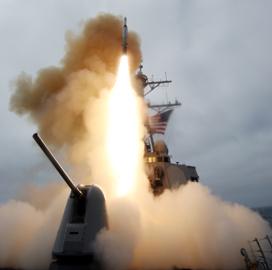 Lockheed Martin conducted an initial flight test of a surface-launch variant of its Long Range Anti-Ship Missile Wednesday at White Sands Missile Range in New Mexico.
Lockheed Martin conducted an initial flight test of a surface-launch variant of its Long Range Anti-Ship Missile Wednesday at White Sands Missile Range in New Mexico.
The company said Thursday it used a topside canister with an angled launch platform to deploy the surface-launched LRASMÂ and simulate a ship-launched environment.
LRASM, booster adapter and the Mk-114 booster lifted off from the topside launcher through the use of the Mk-41 Vertical Launch System’s launch sequencer software during the demonstration.
Lockheed performed the flight test a day after it secured an $86.5 million contract modification to produce LRASMs for the U.S. Air Force.
Scott Callaway, subsonic cruise missile director at Lockheed’s missiles and fire control business, said the test flight seeks to demonstrate the company’s readiness to respond to the U.S. Navy’s demand for anti-surface long-range warfare capabilities under the “Distributed Lethality” concept of operations.
The test also sought to validate LRASM’s capability to be fired from non-VLS and VLS surface platforms, Callaway added.
LRASM is a precision-guided missile designed to help the Navy and Air Force meet combat requirements in contested environments.
An air-launched variant of LRASM is scheduled for installation aboard the Air Force’s B-1B bomber in 2018 and on the Navy’s F/A-18E/F Super Hornet fighter jets in 2019.




